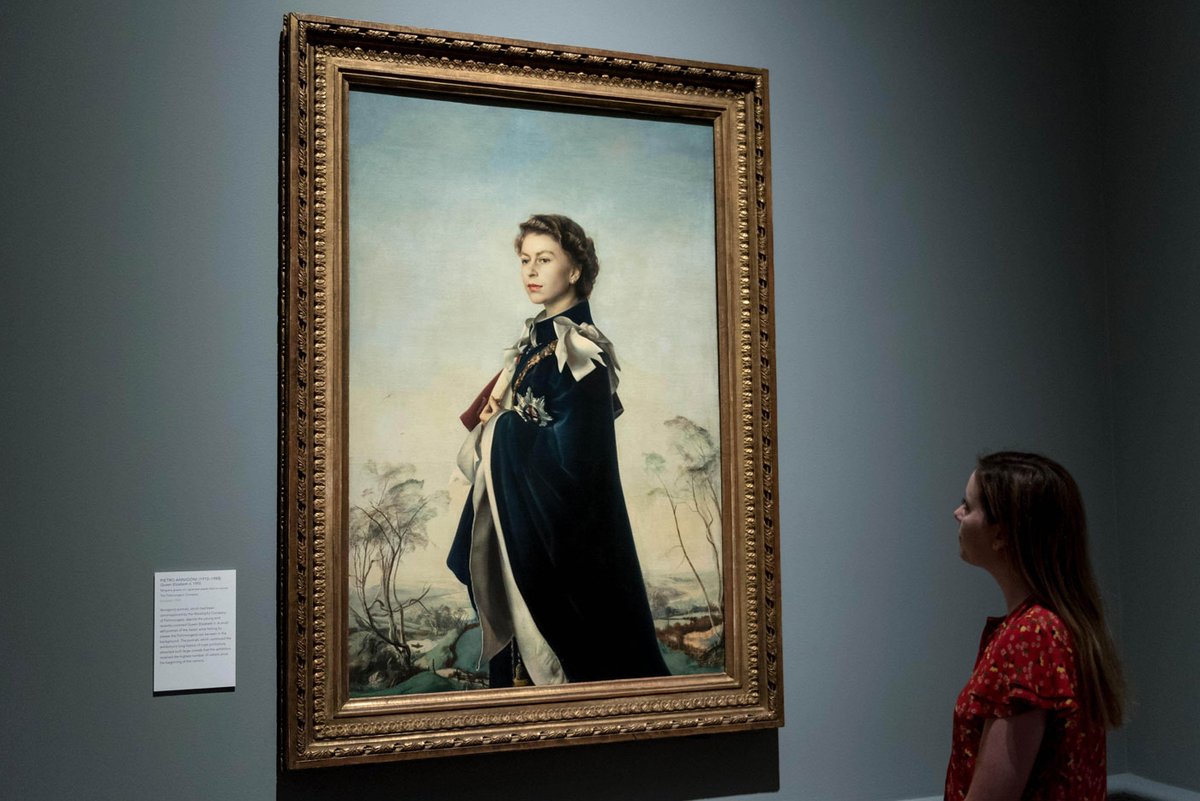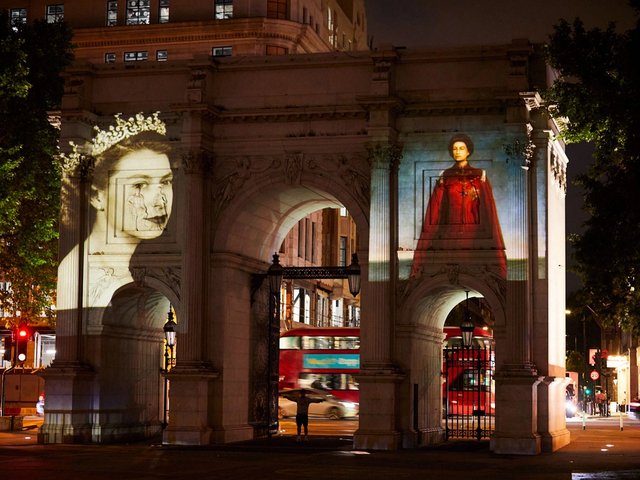English history prefers evolution to dramatic revolution, and Queen Elizabeth II has shown, during her 60-year reign, that she understands this process of “everything must change for everything to remain the same”, as the prince says in the Sicilian novel The Leopard.
You can see it in the way her portraits have evolved. Her official state portrait, painted by James Gunn two years after her accession, could date from 350 years earlier so far as its conventions go: she stands, dressed in coronation robes, her right hand on the table with the crown and sceptre, her cypher on the chair behind her. In recent years, though, she has allowed herself to be portrayed by the famous, if infamously unflattering, Lucian Freud; to be photographed with her eyes shut by Chris Levine; and in a glowering light by Annie Leibovitz. Warhol cheekily appropriated her image for the 1985 “Reigning Queens” series, but this now has an official place at the British embassy in Washington.
There is one conventional painted portrait of her, though, that immediately established itself with the public and establishment. It also made the fortune of the artist, Pietro Annigoni (1910-88), although he very nearly missed painting it because he thought the Fishmongers’ Company was a small organisation of pescivendoli. By chance, an English pupil saw the commissioning letter and explained that the Fishmongers’ is a very rich organisation in the City of London, descendant of the medieval fishmongers’ guild, with an aristocratic membership and palatial headquarters by London Bridge.
Annigoni was a defiant anti-modernist trained in Florence in the traditional medium of tempera grassa, but he is not a misunderstood genius. His many portraits in vaguely Renaissance style are mannered and mawkish and his narrative works, such as the fresco of the Crucifixion in the monastery of San Marco in Florence, are awkwardly composed and slightly embarrassing. He cannot be compared to Josep Maria Sert, author of the paintings in the lobby of the Rockefeller Center, who is as much an outsider to the contemporary art world, but actually has gargantuan artistic vigour.
Annigoni was a defiant anti-modernist trained in Florence in the traditional medium of tempera grassa, but he is not a misunderstood genius
Annigoni, with his first portrait of the Queen (he was to execute another 15 years later that nobody likes much), did, however, have the good fortune to be working in an artistic context even more old-fashioned than his own, so when he introduced a romantic variation on the iconography, he managed to make his painting look fresh and original. Like Samuel Barber’s Adagio for Strings, Annigoni’s Queen Elizabeth II is a work that is loved by thousands, that stands right outside canonical modernity—and that the artist was never to equal.
It was painted when Fishmongers’ Hall was being rebuilt after bomb damage from the Second World War. A portrait of the Duke of Edinburgh was commissioned from Annigoni at the same time to be a pendant at the opposite end of the room, but the duke did not like it, so now it hangs out on the landing.
It is not recorded who originally proposed the Italian artist, but he was already known in London after shows at Wildenstein (1950) and Agnew’s (1952) in Bond Street. Some portraits by the artist were borrowed and shown to the governing body of the Company on 13 May 1954 and a small Portrait Committee was created, which included Sir Harold Wernher, a distinguished general and the owner of Luton Hoo, with its rich art collections. They concluded: “We find great difficulty in suggesting a British artist. In our view the work of the best of them since the war—which has included many portraits of the royal family—has been disappointing.” It was felt that Annigoni had more of the qualities they were looking for than anyone else they knew and that, “like all artists, he has had his work adversely criticised, [but]… he has also had high praise.” He was also known to have refused to paint Hitler and Mussolini, a factor of some importance so soon after the war: “I don’t think he would have been considered if he had been a Fascist”, says Claire Crawford, curator to the Fishmongers’.
Annigoni’s name was duly submitted to the Queen, and she agreed to give him 15 sittings, although he initially asked for 30. The price quoted by the artist was £3,500 for two portraits, or £2,000 for one. In his autobiography of 1977, Pietro Annigoni: An Artist’s Life, he describes how the Queen came into the Yellow Drawing Room in Buckingham Palace wearing the dark blue robes of the Order of the Garter.
He began to draw, but found he had no idea how to pose her.
“Suddenly—perhaps sensing my uneasiness—she began to talk casually in French. ‘You know,’ she said, ‘when I was a child, I used to spend hours in this room looking out of the windows. I loved watching the people and the cars down there in the Mall. They all seemed so busy. I used to wonder what they were doing and where they were all going, and what they thought about outside the Palace.’ Her words were like a searchlight lighting my way. I saw her immediately as the Queen who, while dear to the hearts of millions of people whom she loved, was herself alone and far off. I knew then that was how I must show her.”
Everyone showed a lively interest in the work. The Duke of Edinburgh asked questions about the technique and The Queen Mother told me that the imaginary landscape in the background reminded her of a part of Scotland she knew so wellPietro Annigoni
The picture was a success with the royal family. “Everyone showed a lively interest in the work. The Duke of Edinburgh asked questions about the technique and the Queen Mother told me that the imaginary landscape in the background reminded her of a part of Scotland she knew so well. Princess Margaret, smoking a cigarette in a long holder and enveloped in an air of sensuality, remarked upon my success with her sister’s mouth, a feature, she said, that usually provided great difficulty for portraitists. The Queen herself said that I must be satisfied with my work because everyone in the palace liked it, and it was clear that she was happy for the same reason.”
On 11 March 1955, in an interview with the Scottish Daily Mail, Annigoni explained: “I have tried to depict her as the symbol of the new Elizabethan age, but I wanted to capture in her the spirit of youth. It had to be a portrait of a beautiful young woman.” Of the low, silvery landscape in the Renaissance manner, he said: “It shows the countryside at the end of winter and the dawn of spring. I saw the blue sky as a limitless space to emphasise the limitless opportunities of our time.”
Windsor Castle is away to the right, while to the left is a fisherman in a boat, which could be an allusion to the Fishmongers’, but was also Annigoni congratulating himself: “What nobody knows but me is that at the end of that line is the biggest salmon anyone has ever caught.”
In fact, the picture was to turn into a big money-earner for Annigoni and now the Annigoni Foundation. On 10 March 1955, although the portrait was nearly complete, the contract had still not been signed due to negotiations over copyright. Initially, the Company had the UK rights and Annigoni the foreign rights, but in October 1955, the Company gave him the UK rights in exchange for a donation to its charities. The Company had photographic reproductions made, sold through The Times, and then the more downmarket Daily Sketch did the same, so that for 16s 3d, “those in lonely places throughout the Commonwealth should have the opportunity of seeing the portrait for themselves”.
Over the following 30 years, photographs of it became as ubiquitous in British government offices and diplomatic residences as Chairman Mao in Chinese premises
The Annigoni completely eclipsed the Gunn state portrait. Over the following 30 years, photographs of it became as ubiquitous in British government offices and diplomatic residences as Chairman Mao in Chinese premises. The Ministry of Works, the successor to the Lord Chamberlain's office so far as copies of State portraits were concerned, commissioned a replica in oils by Annigoni’s favourite pupil, Luciano Guarnieri, for the British embassy in Rome, where it still hangs.
It was reproduced on the bank notes of Commonwealth countries from 1961, and the first stamps to use the image were issued by the small colony of Sarawak, on the island of Borneo, in 1955. Since then, Australia, the Isle of Man, Jersey, Fiji, Malta, Mauritius, Rhodesia, the Seychelles and Trinidad and Tobago have all issued Annigoni stamps. As late as 2002, Ghana brought out coinage with the Annigoni on the reverse.
In that Royal Academy Summer show of 1955 at which truly modern art was completely absent (Stanley Spencer was one of the very few artists of interest), the Annigoni was the star. It attracted more visitors than any Summer Exhibition since the First world War—286,000 at 2s a head. Most of the critics were devoutly admiring, but a few were brave enough to demur.
As with certain religious images reproduced in their millions for the faithful, Annigoni’s Queen Elizabeth II defied, or perhaps transcended, mere criticism to lodge itself in the public consciousness. An iconic work indeed
According to Myfanwy Piper, wife of the artist John Piper, in the Sunday Times, there was no need to go to the exhibition “to see Mr Annigoni’s portrait of The Queen—there is a reproduction in almost every periodical in the country. Nothing is lost by reproduction: the paint, in reality, is as smooth and slick as the copy, the pose is that of a clever photograph, just a little different”.
The Observer’s critic saw it as “smooth and meretricious”, while Denys Sutton, later to become a famous editor of Apollo magazine, damned it with faint praise in Country Life: “Gifted with a polite touch, he [Annigoni] has also the skill to infuse the picture with a heroic note.”
In fighting form, Albert Richardson, architect and President of the Royal Academy—lonely defender of neo-classicism at a time when architecture in Britain, unlike the visual arts, had become zealously modernist—responded, in the Daily Telegraph: “It is a fine portrait never mind what the critics say. Critics are owls, bats and fleas. They are owls because they hoot, bats because they see things upside down, and fleas because they nip."
In fact, as with certain religious images reproduced in their millions for the faithful, Annigoni’s Queen Elizabeth II defied, or perhaps transcended, mere criticism to lodge itself in the public consciousness. An iconic work indeed.
- This article was first published in the February 2012 edition of The Art Newspaper




